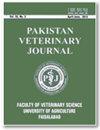求助PDF
{"title":"Macroscopic, Microscopic and Histomorphometric Analysis of Intestine, Liver and Pancreas of Ostrich (Struthio camelus) with Advancement of Age and Sex","authors":"Zaima Umar","doi":"10.29261/pakvetj/2020.029","DOIUrl":null,"url":null,"abstract":"Received: Revised: Accepted: Published online: December 31, 2020 February 26, 2021 March 01, 2021 March 05, 2021 The primary goal of this study was to document the gross morphological and histological structure and histomorphometrical measurements of the intestines and digestive glands of ostrich (Struthio camelus) in relation to advancing age and sex. A total of 40 clinically healthy ostriches of either sex [(20 males, 20 females comprising of two age groups, viz, immature (1 month to 2.4 years) and adult (2.5 to 10 years)] of equal size were selected. Immediately after collection, morphological studies were carried out on all organs. Histological and histometrical studies were conducted on paraffin-embedded tissue sections with Image J analysis software. Macroscopic parameters of the intestines, liver and pancreas invariably showed a rapid increase (P<0.05) during immature age but maintained a plateau with negligible increment in an adult age group. Contrary to other avian species, the length of the small intestine in adult ostriches was 706 cm and the large intestine was 1218 cm which means the length of the large intestine is 1.73 times greater than the small intestine. The length of the colon is also larger than the comparable avian species which increases the digestion of fiber. Thicknesses of all layers of intestines and various parameters of digestive glands had a significant (P<0.05) increase in adults compared to immature ostriches. The growth and maturation of digestive organs in ostriches were not related to sex in each age group. These findings can be extremely beneficial for strategic manipulation of feed and nutrition to enhance the growth rate and diagnose pathological processes. ©2021 PVJ. All rights reserved","PeriodicalId":19845,"journal":{"name":"Pakistan Veterinary Journal","volume":"1 1","pages":""},"PeriodicalIF":3.8000,"publicationDate":"2021-01-01","publicationTypes":"Journal Article","fieldsOfStudy":null,"isOpenAccess":false,"openAccessPdf":"","citationCount":"3","resultStr":null,"platform":"Semanticscholar","paperid":null,"PeriodicalName":"Pakistan Veterinary Journal","FirstCategoryId":"97","ListUrlMain":"https://doi.org/10.29261/pakvetj/2020.029","RegionNum":3,"RegionCategory":"农林科学","ArticlePicture":[],"TitleCN":null,"AbstractTextCN":null,"PMCID":null,"EPubDate":"","PubModel":"","JCR":"Q1","JCRName":"VETERINARY SCIENCES","Score":null,"Total":0}
引用次数: 3
引用
批量引用
随着年龄和性别的增长,鸵鸟肠、肝和胰腺的宏观、微观和组织形态学分析
接收:修订:接受:在线发布:2020年12月31日2021年2月26日2021年3月01日2021年3月05日本研究的主要目的是记录鸵鸟(Struthio camelus)肠道和消化腺的大体形态学和组织学结构以及组织形态学测量与年龄和性别的关系。共选择40只临床健康、体型相等的雌雄鸵鸟[雄性20只,雌性20只,分为未成熟(1个月至2.4岁)和成年(2.5至10岁)两个年龄组]。采集后立即对所有器官进行形态学研究。用Image J分析软件对石蜡包埋组织切片进行组织学和组织学研究。小肠、肝脏和胰腺的宏观参数在未成熟期均呈现快速增长(P<0.05),但在成年期则保持平稳,增长可忽略不计。与其他鸟类不同,成年鸵鸟的小肠长度为706 cm,大肠长度为1218 cm,即大肠长度是小肠的1.73倍。结肠的长度也比同类鸟类大,这增加了纤维的消化。成年鸵鸟各肠层厚度和消化腺各项参数均显著高于未成熟鸵鸟(P<0.05)。各年龄组鸵鸟消化器官的生长和成熟与性别无关。这些发现对饲料和营养的策略性操作,以提高生长速度和诊断病理过程是非常有益的。©2021 PVJ。版权所有
本文章由计算机程序翻译,如有差异,请以英文原文为准。


